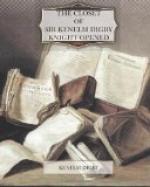Digby imitated his father-in-law who, in similar circumstances, gave himself up to solitude and recollection. His place of retirement was Gresham College. Do its present students remember it once housed a hermit who “wore a long mourning cloake, a high crowned hat, his beard unshorne ... as signes of sorrowe for his beloved wife”? There “he diverted himself with chymistry and the professor’s good conversation.” He had “a fair and large laboratory ... erected under the lodgings of the Divinity Reader.” Hans Hunneades the Hungarian was his operator.
But another influence was at work. For the first time his mind turned seriously to religion. Romanist friends were persuading him to his father’s faith. His old tutor Laud and other Protestants were doing their best to settle him on their side. Out of the struggle of choice he came, in 1636, a fervent and convinced Catholic. He was to prove his devotion over and over again; but I fear that Catholics of to-day would view with suspicion his views on ecclesiastical authority. In his dedication of his Treatise on the Soul to his son Kenelm, there is a spirited defence of the right, of the intelligent to private judgment in matters of doctrine. Nevertheless, his Catholicism, though rationalist, was sincere, and he spent much energy in propaganda among his friends—witness his rather dull little brochure, the Conference with a Lady about Choice of Religion (1638), and his correspondence with his kinsman, Lord Digby, who did, indeed, later, come over to the older faith. Ere long he earned the reputation of being “not only an open but a busy Papist,” though “an eager enemy to the Jesuits.”
From this time dates his close friendship with the Queen, Henrietta Maria, and her Catholic friends, Sir Tobie Matthew, Endymion Porter, and Walter Montague. He and Montague were specially chosen by the Queen to appeal to the English Catholics for aid towards Charles’s campaign in Scotland. Digby was certainly a hot inciter of the King to foolish activity; but in the light of his after history, it would seem always with a view to the complete freedom of the Catholic religion. A prominent King’s man, nay, a Queen’s man, which was held to be something extremer, he played, however, an individual part in the struggle. He was well fitted for the Cavalier role by the magnificence of his person, by his splendid hospitality, his contempt for sects, his aristocratic




